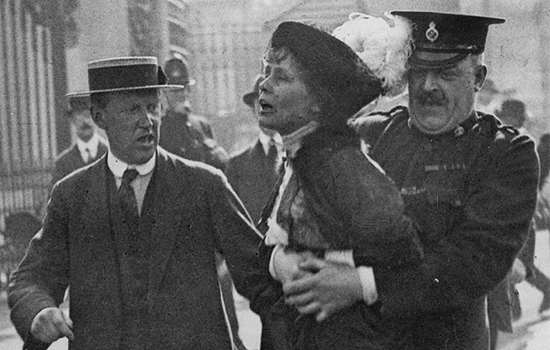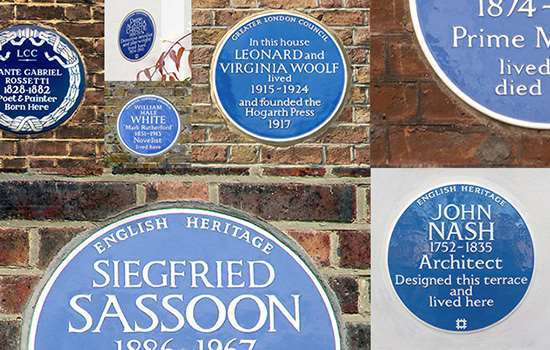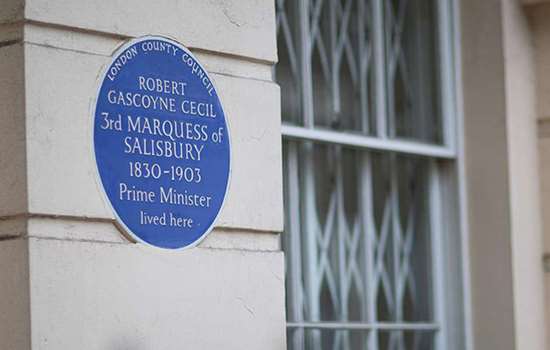HOOKER, Sir William (1785–1865) & HOOKER, Sir Joseph (1817–1911)
Plaque erected in 2010 by English Heritage at 49 Kew Green, Kew, London, TW9 3AA, London Borough of Richmond Upon Thames
All images © English Heritage
Profession
Botanists
Category
Gardening, Science
Inscription
Sir WILLIAM HOOKER 1785-1865 Sir JOSEPH HOOKER 1817-1911 Botanists Directors of Kew Gardens lived here
Material
Ceramic
Since 1851, 49 Kew Green has been the official residence of the director of Kew Gardens. The first two inhabitants, and two of the most influential directors, were Sir William Hooker and his son, Sir Joseph Hooker.
BOTANICAL PIONEER
Born in Norwich in 1785, William Jackson Hooker demonstrated a passion for botany as a young man. By the time he turned 20, he had already discovered a moss previously unrecorded in Britain, now known as Buxbaumia aphylla, which strengthened his conviction that he was ‘determined to give up everything for botany’. This commitment was sealed in 1806 by his election to the Linnean Society, formed for the study of natural history and taxonomy. By 1820 Hooker had been appointed Regius Professor of Botany at Glasgow University, where he proved a popular lecturer and a prolific author, publishing several important studies.
In 1841, William Hooker was appointed director of the newly nationalised Botanic Gardens at Kew, which had fallen into neglect since the death of Sir Joseph Banks in 1820. During Hooker’s 24 years at Kew Gardens, he dramatically increased its size – from 11 acres to 75 acres of botanic garden and 270 acres of arboretum and pleasure grounds – and transformed its appearance by forming the lake, laying out the avenues and vistas, and building over 20 new glasshouses, including the Palm House.
His most lasting innovation, however, was the opening of the gardens to the public from 1pm to 6pm each day. Just 9,000 people visited in 1841 but by 1865 the number had risen to over half a million. At his death in 1865, Hooker had published over 100 volumes of botanical works and had formed an unrivalled herbarium and botanical library, which he bequeathed to Kew.
49 Kew Green is a Grade II listed amalgam of buildings, all of brown brick, dating from the early 18th to early 19th centuries. William Hooker is commemorated within the house by a chimneypiece decorated with a Wedgwood portrait medallion, appropriately flanked by two plaques depicting examples from his favourite plant group – ferns. Since his death, subsequent directors of Kew Gardens and their families have lived at 49 Kew Green, including his son.
LIKE FATHER, LIKE SON
Joseph Hooker attended his father’s lectures from the age of seven. Between 1839 and 1843, he travelled as assistant surgeon and botanist aboard HMS Erebuson on the Ross expedition, sailing the southern oceans. Shortly after his return, Hooker was asked to classify the plants that Charles Darwin had gathered in the Galápagos. It was the beginning of a lifelong collaborative friendship, with Hooker becoming a valuable, though not uncritical, defender of Darwin’s theory of natural selection.
In 1847–9, sponsored by the British government, Hooker travelled to Sikkim in the Himalayas, where he surveyed the flora and sent back about 7,000 specimens to Kew. Sikkim was forced to permit Hooker entry by the British government in India. Hooker was told by the state of Sikkim not to cross the country’s northern border. Hooker and his accompanying government agent, Dr Archibald Campbell, ignored this instruction and were subsequently arrested in 1849. On threat of invasion of Sikkim by the British government, the two men were released. Based on the information he gained in the Himalayas, Hooker’s greatest botanical work, The Flora of British India, appeared between 1872 and 1897.
In 1855, Joseph Hooker was made assistant to his father and on Sir William’s death in 1865 succeeded him as director. In 1873 he was elected President of the Royal Society, through which he promoted wider public participation in science. Joseph Hooker died in 1911.
Kew and the British Empire
Botanists and naturalists attempted to document the natural world, and assess the potential value of its resources. Plants were analysed and specimens taken from across the globe for their uses as sources of food, medicine, clothing, construction and other industries. British entrepreneurs were able to commercially exploit these natural resources from across the globe as part of the ‘imperial project’. Under the Hookers’ directorship, the Royal Botanic Gardens at Kew played an important role in this. They coordinated the movement of plants and seeds all over the world, and employed plant collectors to hunt for the ‘green gold’. Kew Gardens under the Hookers became the ‘botanical arm’ of the Foreign Office and the British empire, recording the natural world, and exploiting its economic potential. This exploitation has been criticised for its subsequent impacts on local populations and their economies, and the local environment.
In 1859–60, William Hooker and Kew helped to transplant cinchona (a tree from which quinine, an anti-malaria drug, was made) from South America to India enabling this lucrative crop to be produced in a British-controlled territory, increasing Britain’s control of the market and its profits. Similarly, under Joseph Hooker’s direction in the 1870s, rubber seeds (Hevea brasiliensis) from Brazil, were germinated and grown at Kew for British colonies such as Ceylon (now Sri Lanka) and Singapore, where production competed with rubber production in South America.
KEW AND THE HOOKER LEGACY
The Royal Botanic Gardens at Kew now receive almost two million visitors a year, fulfilling William Hooker’s original vision for Kew. Kew is a globally significant research centre for plant sciences. It continues the tradition established by William and Joseph Hooker: to better understand plants across the globe. However, Kew today is also committed to helping to stop biodiversity loss and to protect plants and fungi ‘for the well-being of people and the future of all life on Earth’.
FURTHER READING
- J Endersby, Imperial Nature: Joseph Hooker and the Practices of Victorian Science (University of Chicago Press, 2008)
- J Endersby, ‘Hooker, Sir Joseph Dalton (1817–1911)’, Oxford Dictionary of National Biography (Oxford, 2009). (public library subscription required)
- S FitzGerald, ‘Hooker, Sir William Jackson (1785–1865)’, Oxford Dictionary of National Biography (Oxford, 2009). (public library subscription required)
- Read & Watch: Re-examining the history of botanical collections
- Watch: Gardens of Empire: The Role of Kew and Colonial Botanic Gardens
- Kew’s Science Strategy
Nearby Blue Plaques
More About Blue Plaques



